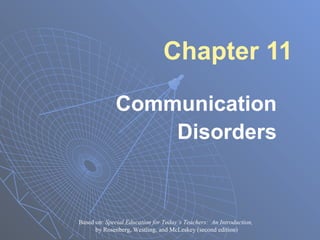
Chapter 11: Communication Disorders
- 1. Chapter 11 Communication Disorders Based on: Special Education for Today’s Teachers: An Introduction, by Rosenberg, Westling, and McLeskey (second edition)
- 2. Chapter 10 Questions What are language and speech disorders? What are the main types of language and speech disorders? How are communication disorders identified? What kinds of service delivery options are used? What are some ways that teachers can collaborate with speech therapists?
- 3. Communication Disorders IDEA definition: a communication disorder such as stuttering, impaired articulation, language impairment, or voice impairment that adversely affect a child’s educational performance. Language disorders – problems receiving, understanding, and formulating messages. Speech disorders – problems related to the verbal transmission of messages.
- 4. Language Disorders Form Disorders • Phonology - sounds used to make word parts (e.g., 40 phonemes in English language) • Morphology - rules for constructing words (e.g., plurals, suffixes) • Syntax - rules for connecting words together (e.g., word order, organization) Content Disorders • Semantics - rules that dictate meaning (e.g., vocabulary) Use Disorders • Pragmatics – application of language in social contexts (e.g., conversation)
- 5. Speech Disorders Articulation Disorders (common) • Phonological – mental representation problem (can make sound, but doesn’t) • Articulation – structural problem (can’t make sound) • Substitutions, omissions, additions, distortions Fluency Disorders – interruptions in the flow of speaking (e.g., stuttering) Voice Disorders - pitch, duration, intensity, resonance, vocal quality Motor Speech Disorders • Apraxia - lack of coordinated muscle movement • Disarthria – weak, slow, or paralyzed muscles
- 6. Should I Talk to the SLP? How is the student’s intelligibility? (By age 4, should be 100%.) How easy is it to communicate with the student? (Can you have a normal conversation?) How does the student interact with others? (Does s/he avoid talking?) Does the student have unusual speech characteristics (e.g., substitution, omission, stuttering, hoarseness, etc.)?
- 7. Identification Review developmental, educational and medical history Interview parents, teachers, etc. Questionnaires Systematic observation Language sampling Formal tests
- 8. Service Delivery Service Delivery Models • Monitoring • Collaborative consultation • Classroom-Based • Pullout Issues • Shortage of SLPs • Heavy caseloads
- 9. Collaboration Discuss concerns about students Know what student is working on Ask how you can help students achieve and generalize skills Communicate progress Discuss behavioral challenges Ask how to improve the communication skills of the whole class.
